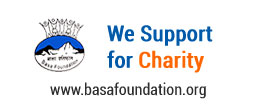Bhutan – Land of the Thunder Dragon is one of the most exotic destinations in the world today. This kingdom, often referred to as the last Shangri-la, is a land of outstanding people, remarkable scenery and natural wonders, and a proud and vibrant culture. A unique and rare place that few have had the privilege of visiting. Wedged between the world’s giants, India and the Tibetan region of China, Bhutan is today slowly opening up to the world through a sensitive approach to tourism.
You can now discover the cultural and natural wonders of this last remaining Mahayana Buddhist Kingdom of the Himalaya. Here is a kingdom that is just throwing off the veil of mystery, and opening its doors to visitors. Bhutan has a pristine environment, almost no pollution, and a living culture where festivals and cultural events are a part of daily life and not creations for tourism. Let us take care of your needs on your tour of this little known kingdom.
History
The ancient period of Bhutan that dates from the beginning till the 8th century AD, was marked by rural settlement, domestication of animals, agriculture, the first advent of Buddhism and subsequent buildings of Buddhist temples. The visit of Guru Padmasambhava and other Buddhists saints and scholars from India and Tibet marked the medieval Bhutan. Emergence of ruling clans and development of arts and architecture were also seen during this period. Shabdrung Ngawang Namgyal, a leader of the Drukpa sect, came to Bhutan in 17th century. He introduced the dual system of Government and for the first time some degree of stability was maintained, which was unseen before. But this did not last long. After Ngawang Namgyal’s death, successors became victims of intrigues and rivalries. The instability continued till the early 20th century.
The country’s modern period began with the establishment of monarchy in Bhutan. The powerful Bhutanese Chief, Ugyen Wangchuk was crowned as the first hereditary ruler of Bhutan in 1907. The country’s self-imposed policy of isolation continued till the reign of the third king Jigme Dorji Wangchuk. He decided to shed this age-old policy and introduced the country to the outside world, bringing the country into the international mainstream. Though the country is known as Bhutan to the outside world, to Bhutanese it has been known as Druk Yul ‘Land of the Thunder Dragon’. The people call themselves Drukpas.
Geography
Bhutan is a landlocked country wedged between the autonomous region of Tibet, China, in the north and India in the south along the lofty mountains of the eastern Himalayas. It is located between 88°45'and 92°10' longitude east and between 26°40' and 28°15' latitude north. It covers 46,500 square kilometers and has population of 650,000 with seventy five percent of the population living on cultivation and livestock rearing.
The country can be divided into three major geographic zones: the southern foothills and plains with hot and humid climate, the hills and valleys in the center with moderate rainfall and the highland of the north with high mountains covered with snow almost through out the year.
Bhutan is the land of complex gorges and valleys, soaring snow-peaked mountains and steep slopes, humid jungles and foothills, magnificent lakes and waterfalls, fast flowing rivers and streams and the richest biodiversity of flora and fauna.
People & Dress
The people of Bhutan can be classified into three main ethnic groups: Sharchops, who live in east of the country, are believed to be the earliest inhabitants of Bhutan. They are Indo-Mongoloid origin and appear closely related to the inhabitants of northeast India and northern Burma. The Ngalongs are of Tibetan descendant migrated to Bhutan in the 9th century and settled west of the country. The third group Lhotsampas are the Nepali origin that settled in the foothills of southern Bhutan in mid 19th century. There are other minority groups in Bhutan such as Layap, Brokpa, Doya, Lhopu, Dhakpa and Lepcha.
The men wear a knee-length garment called ‘Gho’ which resembles the Scottish Kilt. The women wear a long robe ‘Kira’, which is wrapped around the body covering it from neck to ankle. Women usually wear heavy silver and gold necklaces with coral, turquoise and other precious stones. Rings and earrings decorated with pearls and turquoise are also popular.
Religion
The early inhabitants of Bhutan practiced ‘Bonism’, a practice of making animal sacrifice and worshiping non-living objects such as mountains, lakes, rivers, trees and rocks. With the advent of Buddhism in 7th century the Bonism gradually disappeared from the country.
The country’s official religion is Drukpa Kagye, school of tantric Mahayana Buddhism, which is similar to Tibetan Buddhism but has unique beliefs and practices. The religious affair of the country is looked after by the Je Khenpo (Chief Abbot) who also enjoys equal power as the king.
The Bhutanese people of Nepali origin in the south practice Hinduism.
Language
The national language of Bhutan is Dzongkha, which is widely spoken in western region. The eastern region of the country speak Sharchop, where as the people in the south speak Nepali.
English has been used as the medium of instructions in schools and institutes. The country’s national newspaper Kuensel is written in English, Dzongkha and Nepali.
Food & Drink
The staple food of Bhutanese is rice and vegetables with abundant chillies. Bhutanese eat incredible amount of chillies. It is used as vegetable rather than as spices. Most Bhutanese prefer ‘Emadatse’ a dish made entirely of chillies mixed with cheese. Meat is widely eaten in Bhutan. Common meat includes pork, beef, chicken, fish and yak meat. The Bhutanese also eat a variety of vegetables, including potatoes, fern, spinach, cabbage, cauliflower, beans and mushrooms.
In central Bhutan, buckwheat is cultivated as one of the main cereals. The rice is not grown due to high altitude. The Bumthang region is famous for its buckwheat pancakes. The Bhutanese are fond of taking ‘suja’ (butter tea) and ‘ara’, an alcohol distilled from the brewery of locally produced rice, wheat, maize or corn. Drinks are also used as a part of offerings while performing ceremonies on different occasions.
Festivals
The annual festival is called ‘Tshechu’. It is one of the most exciting experiences that the visitor can have in Bhutan. It is celebrated in honour of Guru Padmasambhava who visited Bhutan in 7th century.
During the Tshechu, the monks and laymen perform mask dances and the religious skits. It is also the time for the people to socialize and rejoice. Men, women and children are attired in their best silk and brocade, and intricately woven colourful ghos and kiras. In some festivals you can witness the unveiling of a "thongdrel," (a giant appliquéd thangka) that is hung from a wall in the Dzong’s courtyard. Punakha Dzong has the largest thongdrel in Bhutan.
Flora & Fauna
Bhutan has about 72% of its area under forest cover. Over 5000 species of plants grow in Bhutan. These include 300 species of medicinal plants, over 50 species of rhododendron and 600 species of orchids.
The great variety of fauna includes: elephants, tigers, buffalo, one horned rhinoceros (rhinoceros unicornis), leopards (panthara pardus), gaur, red pandas, langur monkeys, wild boar, deer, white-collared black bears, yaks (bos gruniens), tahr (hemitragus jemlahicus) and goral (naemorhedus goral). Brown trout and local fishes are found in northern rivers and lakes, while in the south the rivers are full of masheer.
The rare and exotic species found in Bhutan are: golden langur (found only in Bhutan), pangolin, pygmy hog, snow leopard, red pandas, wild buffalo, monal peasant, peacock peasant, raven, rufous-necked hornbill, white-bellied heron, common shelduck, ruddy duck, black necked crane, golden masheer, spotted deer, leopard, leopard cat, himalayan black bear, serow, snow leopard, takin, musk deer, himalayan brown bear, himalayan marten, tiger, hornbills, pheasants, mountain goats and timid blue sheep. About 675 species of birds have been recorded in Bhutan and more than 16 different species of birds are included in the lists of endangered species.
Economy
Bhutanese economy is predominantly agrarian. About 75% of the population depends on subsistence farming and livestock rearing. The food crops are rice, maize, millet, wheat, buckwheat and barley. The cash crops include apples, oranges, potatoes, cardamom and mustard.
Bhutan exports agro products like apples, oranges, mushrooms, canned fruit and jams. The country also exports forestry products like timber and lemon grass oil. Cement, ferro alloys, calcium carbide, coal and gypsum are also exported.
Tourism is the largest foreign exchange earner for Bhutan. The country’s largest source of earning is the hydroelectric power. It contributes about 25% of the government revenue. Bhutan also exports postage stamps.








